АНТИПРОЛИФЕРАТИВНЫЙ ПОТЕНЦИАЛ И АНТИОКСИДАНТНАЯ АКТИВНОСТЬ НОВЫХ КООРДИНАЦИОННЫХ СОЕДИНЕНИЙ IN VITRO
Гарбуз О.С.1, Граур В.О.2, Тагадюк О.К.3, Андронаке Л.М.4, Сардарь В.В.5, Гулеа А.П.6, Гудумак В.С.7
1ORCID: 0000-0001-8783-892X, Аспирант; Молдавский Государственный Университет; Кишинёв, Молдова;
2ORCID: 0000-0001-8153-2153, Кандидат химических наук; Молдавский Государственный Университет; Кишинёв, Молдова;
3ORCID: 0000-0002-5503-8052, Доктор медицинских наук, Государственный университет медицины и фармации им. Н. Тестемицану, Кишинёв, Молдова
4ORCID: 0000-0002-8781-8037, Кандидат медицинских наук; Государственный университет медицины и фармации им. Н. Тестемицану, Кишинёв, Молдова;
5ORCID: 0000-0002-1047-9145, Кандидат медицинских наук; Государственный университет медицины и фармации им. Н. Тестемицану, Кишинёв, Молдова;
6ORCID: 0000-0003-2010-7959, Доктор химических наук, Профессор, Академик АН, Молдова; Кишиневский Государственный Университет, Кишинёв, Молдова;
7ORCID: 0000-0001-9773-1878, Доктор медицинских наук, Профессор; Государственный университет медицины и фармации им. Н. Тестемицану, Кишинёв, Молдова
АНТИПРОЛИФЕРАТИВНЫЙ ПОТЕНЦИАЛ И АНТИОКСИДАНТНАЯ АКТИВНОСТЬ НОВЫХ КООРДИНАЦИОННЫХ СОЕДИНЕНИЙ IN VITRO
Аннотация
В данной работе была изучена способность координационных соединений TIA-90, TIA-91 и TIA-93 индуцировать ингибирование пролиферации в эпителиальных клетках карциномы поджелудочной железы линии BxPc-3. Также была исследована их цитотоксичность в отношении нормальных эпителиальных клеток почки собаки Madin Darby линии MDCK. Жизнеспособность раковых клеток определяли по тесту Alamar Blue с использованием окислительно-восстановительного индикатора ресазурина. Для выявления антиоксидантных свойств координационных соединений TIA-90, TIA-91 и TIA-93 мы использовали относительно простой, но надежный ABTS-метод. Полученные результаты показали, что вещества TIA-90 и TIA-93 обладают высоким антипролиферативным и антиоксидантным потенциалами. Цитотоксическая активность этих соединений в отношении нормальных клеток линии MDCK ниже, чем в опухолевых клетках, что указывает на перспективность их использования в качестве противоопухолевых средств. Однако, необходимы дополнительные исследования для оценки механизмов действия этих соединений, а также для выявления их возможных побочных эффектов в других биосистемах и опытах на животных.
Ключевые слова: антипролиферативная активность, цитотоксичность, антиоксидантная активность.
Garbuz О. S.1, Graur V. O. 2, Tagadiuc O.C. 3, Andronache L. M. 4, Sardari V. V. 5, Gulea А. P. 6, Gudumac V. S.7
1ORCID: 0000-0001-8783-892X, Postgraduate student; Moldova State University, Chisinau, Moldova;
2ORCID: 0000-0001-8153-2153, PhD in Chemistry; Moldova State University, Chisinau, Moldova;
3ORCID: 0000-0002-5503-8052, MD, State University of Medicine and Pharmacy “Nicolae Testemitanu”, Chisinau, Moldova
4ORCID: 0000-0002-8781-8037, MD; State University of Medicine and Pharmacy “Nicolae Testemitanu”, Chisinau, Moldova;
5ORCID: 0000-0002-1047-9145, MD; State University of Medicine and Pharmacy “Nicolae Testemitanu”, Chisinau, Moldova;
6ORCID: 0000-0003-2010-7959, PhD in Chemistry, Professor, Academician ASM, Moldova; Moldova State University, Chisinau, Moldova;
7ORCID: 0000-0001-9773-1878, MD, Professor; State University of Medicine and Pharmacy “Nicolae Testemitanu”, Chisinau, Moldova
IN VITRO ANTIPROLIFERATIVE POTENTIAL AND ANTIOXIDANT CAPACITY OF NEW COORDINATION COMPOUNDS
Abstract
In the present study the ability of coordination compounds TIA-90, TIA-91 and TIA-93 to induce the inhibition of proliferation in the epithelial cells of pancreatic carcinoma of the BxPc-3 line were investigated. Their cytotoxicity against normal kidney epithelial cells of Madin Darby dog's MDCK line was also evaluated. The viability of cancer cells was determined by the Alamar Blue test using the redox indicator of resazurin. To identify the antioxidant properties of TIA-90, TIA-91 and TIA-93 anticancer agents, we used a relatively simple but reliable ABTS method. Obtained results showed that the compounds TIA-90 and TIA-93 have greet antiproliferative and antioxidant potentials. The cytotoxic activity of these compounds against normal cells of the MDCK line is lower than that on tumor cells, which indicates the prospect of their use as antitumor agents. However, additional studies are need to evaluate the mechanisms of action of these compounds, as well as their possible adverse effects in other bioassay systems and animal models.
Keywords: antiproliferative activity; cytotoxicity; antioxidant activity.
Introduction
Pancreatic cancer has the worst prognosis of all gastrointestinal malignancies, and the difficulty of diagnosing the disease in its early stage results in 70–80% of patients being deemed unresectable, either because the disease is locally advanced or accompanied with distant metastasis [1], [2]. Despite significant progress made in cancer chemotherapy, high systemic toxicity and antineoplastic chemotherapy resistance remains a major challenge for oncology contemporary pharmacotherapy.
The antiproliferative effects of compounds were determined using pancreatic carcinoma cells of line BxPc-3 but, anticancer compounds should kill the cancerous cell with the minimal side effect on normal cells, therefore for selective cytotoxicity evaluation we exploited Madin Darby Canine Kidney epithelial normal cells of line MDCK. For measurement of antiproliferative activity was used Resazurin assay, also known as Alamar Blue assay, which works as a cells viability and proliferation indicator, through the conversion of resazurin to resorufin [3].
Forasmuch as prooxidants produce adverse modifications to cell components, the anticancer substances shouldn't be prooxidants [4], [5]. In that regard, we explored the antioxidant capacity of experimental complexes by ABTS assay and their potency was compared with that of the positive control, Trolox.
Experimental
In vitro antiproliferative activity
Cell Culture conditions
Human epithelioid pancreatic adenocarcinoma cells of line BxPc-3 (Fig. 1) was cultured as monolayer in the Roswell Park Memorial Institute (RPMI) 1640 medium and Madin Darby Canine Kidney epithelial normal cells of line MDCK (Fig. 2) in the Dulbecco’s Modified Eagle Medium (DMEM) high glucose (Invitrogen) containing L-glutamine, bovine albumin fraction (V7.5%) 0,2% v/v (Invitrogen), HEPES buffer (N-2 hydroxyethylpiperazine-N’-2-ethane sulfonic acid) 20mM (Invitrogen), antibiotics penicillin-streptomycin (final concentration 100 U/ml penicillin and 100 μg/ml streptomycin sulfate) (Invitrogen) and supplemented with fetal bovine serum (FBS-irradiated) 10% v/v (Cambrex) in 75 cm2 falcon culture flasks (Cellstar) and incubated in 2% CO2, 78% air in humidified atmosphere at 37°C with medium renewal every 2–3 days.
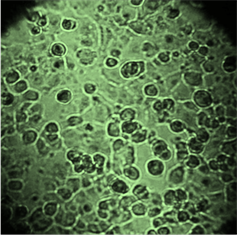
Fig. 1 - BxPc-3 cell line in culture
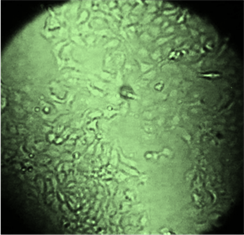
Fig. 2 - MDCK cell line in culture
Resazurin assay
Cells were trypsinized from subconfluent cultures by adding 3 ml of trypsin-ethylenediaminetetraacetic acid (trypsin-EDTA) 0,05% (Invitrogen) to 50 ml falcon flasks with confluent cells followed by 5 min incubation at 37°C. The trypsin reaction was stopped by adding 10 ml of appropriate culture medium containing 10% FBS. The cell suspension was centrifuged at 750 rpm for 10 min. The cell pellet was suspended in 2 ml of medium with 10% FBS and thoroughly mixed. Cells were counted and brought to a concentration of 1 × 105 cells/ml. The resulting cell suspension was seeded into duplicate wells of a 96-well microtiter plat (90µl/well) and incubated at 37°C, 2% CO2. After an initial 4 h period to allow cell attachment, 10 µl of compounds TIA-90, TIA-91, TIA-93 and Doxorubicin hydrochlorid (DOXO) in different dilutions were directly added to the medium resulting. They was dissolved in dimethyl sulfoxide (DMSO) to prepare the stock solution of 10 mM/L, which were used as reference at final concentrations ranging from 100; 10; 1; 0,1 µM/L. These compounds and DOXO was incubated for 24 hours. Following each treatment, 20 µl resazurin indicator solution was added to each well and incubated at 37°C, 2% CO2 for 4 hours. Subsequently, the absorbance was read with 570 nm and 600 nm filters. The measurement was made by imaging hybrid reader (BioTek).
The percentage inhibition was calculated according to the formula:
100-((Abs570nmsample-Abs600nmsample)/(Abs570nmcontrol-Abs600nmcontrol)×100)
As an indicator of efficiency of the experimental compounds on proliferation of cancer cells was used the half maximal inhibitory concentration (IC50).
In vitro determination of antioxidant activity
Chemicals
Chemicals and reagents used were of analytical grade and obtained from Sigma: 2,2'-Azinobis-(3-ethylbenzothiazoline-6-sulfonic acid) (ABTS), 6-hydroxy-2,5,7,8-tetramethychroman-2-carboxylic acid (Trolox), potassium persulfate (K2S2O8). Doxorubicin hydrochlorid (C27H29NO11HCl) (Naprod, India). DMSO (dimethylsulfoxide), methanol, acetate buffered saline (pH 6,5) were purchased from local suppliers. Deionized water was obtained, Adrona Water treatment system Crystal E HPLC.
ABTS•+ radical cation scavenging assay
The antioxidant activity by the ABTS•+ method was assessed according to the method described by Re et al. [6] with modifications. The ABTS•+ radical was formed through the reaction of ABTS•+ solution 7 mM with potassium persulfate solution 140 mM, incubated at 25 °C in the dark for 12–16 hours. Once formed, the ABTS•+ solution was diluted with acetate buffered saline (0,02M, pH 6,5) to give an absorbance of 0.7 ± 0.01 at 734 nm.
Were prepared dilutions of trolox, DOXO, TIA-90, TIA-91 and TIA-93 in DMSO at concentrations ranging from 3.125 to 100 μM/L. After that, 20 μL of each experimental complexes dilution were transferred in a 96 wells microtitre plate and 180 μL of working solution of ABTS•+ were dispensed with dispense module of hybrid reader (BioTek), shake 15 s. The decrease in absorbance at 734 nm was measured exactly after 30 min of incubation at 25 °C. Blank samples were run by solvent without ABTS•+.
The decrease in absorbance is expressed as % inhibition, which is calculated from the following formula:
((Abscontrol–Abssample)/Abscontrol)×100
Results and discussion
Comparative study and concentration ranges identification of cytotoxic activity of coordination compounds TIA-90, TIA-91 and TIA-93 in vitro in regard to pancreatic cancer cell line BxPc-3 are shown in Fig.3.
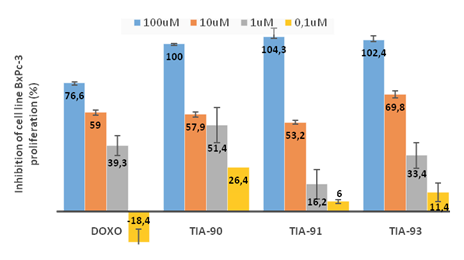
Fig. 3 – Inhibitory effect of DOXO, TIA-90, TIA-91 and TIA-93 on the proliferation of pancreatic cancer cells line BxPc-3
Antiproliferative activity experiments showed that there is concentration dependence between inhibitory effect of the complexes at the micromolar range. Complexes TIA-90, TIA-91 and TIA-93 inhibit the formation and growth of BxPc-3 cell line, that's demonstrate its capacity to inhibit the proliferation of tumor cells. It was founded, that the IC50 values are 2±0,6 µM/L for TIA-90; 7,3±1,5 µM/L for TIA-91, and 2,5±0,7 µM/L for TIA-93. IC50 of reference drug DOXO was found to be 6±0,8 µM/L. Thus, was established that, coordination compounds TIA-90 and TIA-93 exhibit stronger inhibitory activity on BxPc-3 cells proliferation than DOXO. The inhibitory activity of TIA-91 is comparable to that of the clinically used anticancer drug DOXO.
Concomitant was founded, that the cytotoxic activity of complexes TIA-90, TIA-91 and TIA-93 on normal cells line MDCK (Fig. 4) is lower than that exerted on the tumor cells, and lower than that exerted by DOXO.
Thus, the IC50 values for MDCK are 14,4±2,6 µM/L for TIA-90; 12,4±1 µM/L for TIA-91; 11,2±0,3 µM/L for TIA-93 and 7±2,3 µM/L for DOXO.
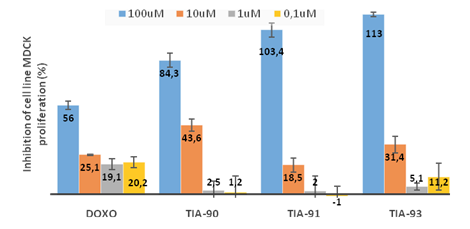
Fig. 4 – Inhibitory effect of DOXO, TIA-90, TIA-91 and TIA-93 on the proliferation of Madin Darby Canine Kidney epithelial normal cells of line MDCK
Among the compounds tested for antioxidant activity, TIA-90 exhibited the highest antioxidant activity with the IC50 value of 21±9 µM/L, while IC50 of reference compound trolox was found to be 32±0,9 µM/L. Other moderately active compounds, TIA-91 and TIA-93 showed the IC50 values of ≥100 µM/L and 55±7,9 µM/L, respectively. Analyzing the research results of ABTS method, we observe that complex TIA-90 showed the best antioxidant activity compared with Trolox (Fig. 5).
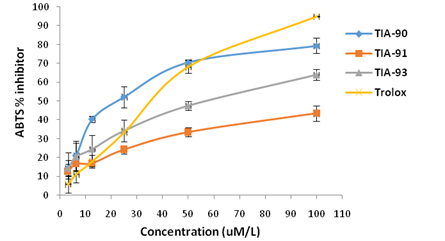
Fig. 5 – ABTS•+ radical scavenging activity of DOXO TIA-90, TIA-91 and TIA-93
Conclusion
Results conclude that the coordination compounds TIA-90, TIA-91 and TIA-93 were effective in inhibiting the pancreatic tumor. The compounds TIA-90 and TIA-93 exhibit stronger inhibitory activity on pancreatic cancer cells line BxPc-3 cells proliferation than doxorubicin. The antioxidant studies were also supported its antitumor properties. The cytotoxic activity on normal cells is lower than that to the tumor cells, being lower than that exerted by doxorubicin. Additional studies are needed to evaluate the mechanism of action of these compounds as well as the adverse effects in other bioassay systems and animal models.
Список литературы / References
- Wray C. J. Surgery for pancreatic cancer: Recent controversies and current practice / C. J. Wray, C. J. Wray, S. A. Ahmad, J. B. Matthews and A. M. Lowy // Gastroenterology. – 2005. – Vol.128. – P.1626–1641.
- Furuse J. The Hepatobiliary and Pancreatic Oncology (HBPO) Group of the Japan Clinical Oncology Group (JCOG): History and future direction / J. Furuse, H. Ishii and T. Okusaka // Jpn J Clin Oncol. – 2013. – Vol.43. – P. 2–7.
- Anoopkumar-Dukie S. Resazurin assay of radiation response in cultured cells/ S. Anoopkumar-Dukie, J.B. Carey, Conere , E. O’Sullivan, F. N. Van Pelt, A. Allshire // British Journal of Radiology. – 2005. – Vol. 78 (934). – P. 945–947.
- Mohamed A. Ismail. Anticancer, antioxidant activities, and DNA affinity of novel monocationic bithiophenes and analogues/ Mohamed A. Ismail, Reem K. Arafa // Drug Design, Development and Therapy. –2014. – 8. – P. 1659—1672.
- Dilovic I. Novel thiosemicarbazone derivatives as potential antitumor agents: Synthesis, physicochemical and structural properties, DNA interactions and antiproliferative activity / I. Dilovic, M. Rubcic, V. Vrdoljak // Bioorg. Med. Chem. – 2008. – Vol. 16. – P. 5189–5198.
- Re R. Antioxidant activity applying an improved ABTS radical cation decolorization assay./ Re, N. Pellegrini, A. Proteggente, A. Pannala, M. Yang, C. Rice-Evans // Free Radic Biol Med.– 1999. – Vol. 26 (9-10). – P.1231-1237.
